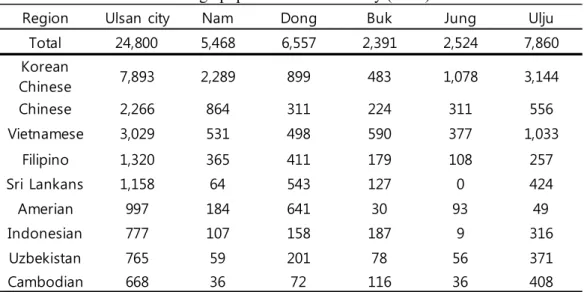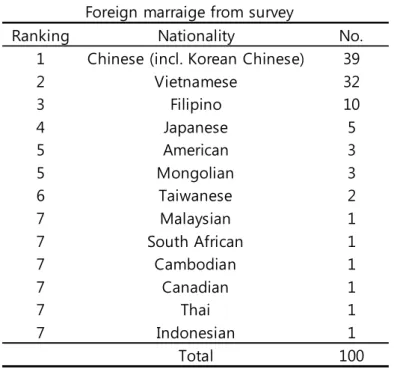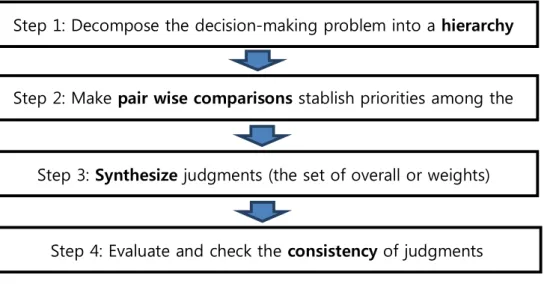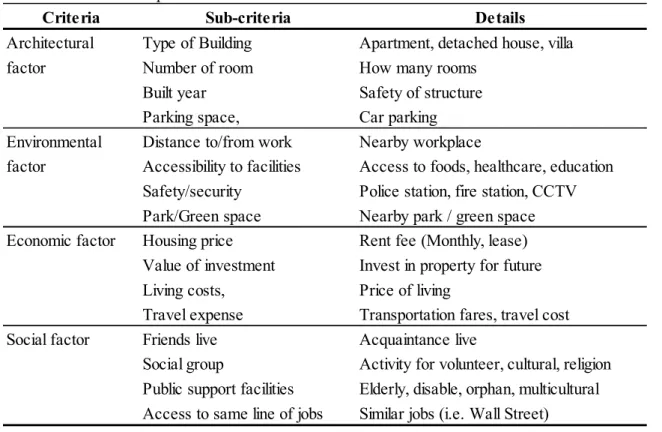From a practical perspective, this study suggests that there is a difference in residential location choice preference between domestic female residents and foreign-born female residents. Moreover, the foreign-born female residents strengthen themselves in a regional area through their own native nationality network.
Purpose of Study
Second, we understood the main drivers of living in and territories of ethnic neighborhoods by applying the qualitative method approach, using in-depth interviews to capture the needs and complaints of foreign-born female residents. Third, we empirically proposed a housing policy for foreign-born residents by substantially projecting their needs, thoughts, and complaints.
Research Questions
Hypothetically, we expect economic factors such as housing costs and investment prospects to be the most important factors for both foreign and domestic residents. However, we hypothesized that foreign residents are more concerned about social factors such as proximity to friends and relatives, social groups, and the ability to live in a residential location that approximates that of their Korean counterparts.
Outline Methodology
We speculate that the determinants of residential location choice might show considerable variation by nationality.
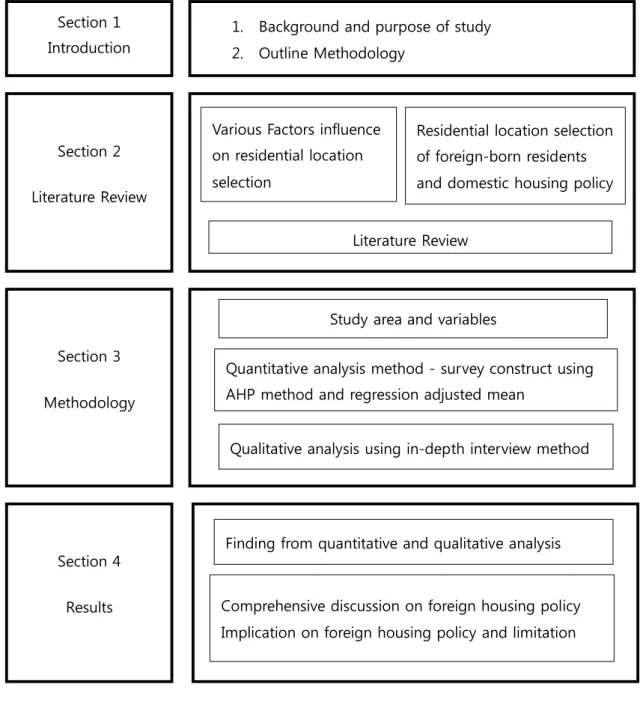
Theoretical framework and literature review
- Various factors that have influence on residential location selection
- Residential location selection of foreign-born residents
- Housing Policy for Foreign-born population
- Analytic Hierarch Process (AHP) Method
There are few studies on housing policy for foreign-born residents, although the number of foreign residents continues to grow. In general, not many studies have been conducted on the preferences of foreign-born residents in terms of determining residential location selection.
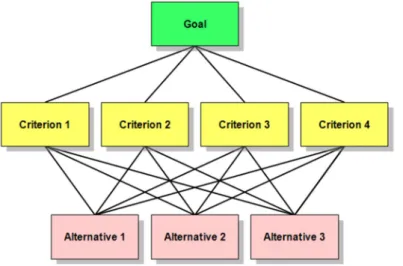
Methodology
- Study Area
- Sample
- Quantitative Analytical method
- Constructing the Survey using AHP Method
- Principal Component Analysis (PCA)
- Estimating adjusted preferences
- Qualitative method: In-depth Interview
Secondly, a qualitative method was used to supplement the results of the quantitative data by conducting an in-depth interview to identify the foreign-born woman's needs in relation to the choice of residential location. For the quantitative analysis, we constructed a study on the importance of the four decision-making factors in choosing a residential location using the Analytic Hierarchy Process (AHP) method. We used an analytic hierarchy process to examine the determinants of the domestic and foreign population's choice of residential location.
Next, we supplemented the results of the quantitative analysis method by conducting an in-depth interview of the survey participants. First, we multiplied each column of the pairwise comparison matrix by the corresponding weight. Next, we supplemented the results of the survey analysis by conducting semi-formal in-depth interviews of resident foreign female survey participants.

Results
Descriptive statistics
Question 7 Is there any comment or suggestion and recommendation that you would like to tell the Korean government regarding housing policy issues to make a better housing policy for foreign-born residents. The proportion of married foreign-born respondents was more than twice that of unmarried respondents. The number of foreign-born respondents with a household income of less than 1 million KRW was twice the number of respondents with an income of more than 1 million KRW.
Depending on the type of residence, foreign-born residents were more likely to live in non-residential dwellings than native residents. The survey results also showed that native residents are more likely to be married than foreign-born residents. In addition, native residents were more likely to have children, own a house, and be elderly than foreign-born residents.
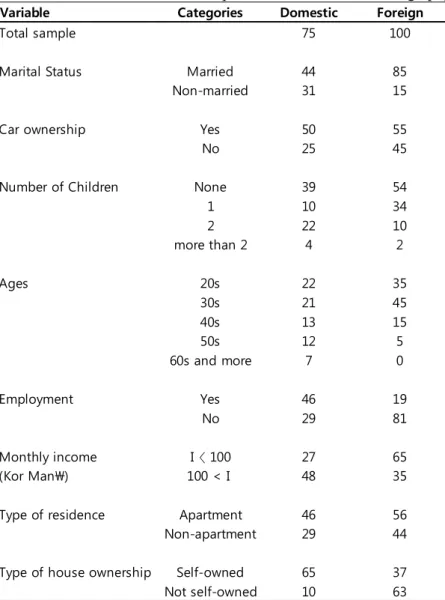
Analytic Hierarchy Process (AHP)
From Figure 7, for level 1, native female residents and foreign-born female residents both indicated that physical has a higher weight than non-physical, but foreign-born female residents indicate that non-physical is slightly higher than native residents. Native residents clearly indicated that the environment is more important than foreign-born residents, however, foreign-born residents strongly emphasized this. However, the priority of the elements for native residents and foreign-born residents were slightly different at level 3.
In terms of economic factors, many native-born residents place more weight on investments, while most foreign-born residents place more weight on cost of living. Regarding the social factor, "where friends live" was the most important for locals, while "access to similar employment" was the most important for residents born abroad. Based on the results of Figure 7, it can be concluded that native-born and foreign-born residents generally have similar characteristics regarding residential locations before adjusting for means.
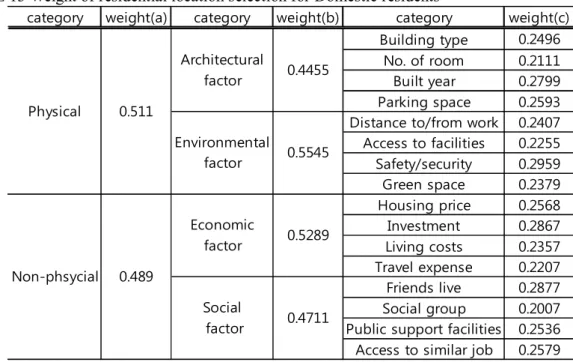
Adjusted mean by regression
- Domestic vs Foreign
Tables 15 and 16 show the results of domestic residents and foreign-born residents adjusted by regression.
Based on Figure 9, the results are generally similar in pattern for both domestic and foreign unadjusted averages. At level 1, Physical is greater than non-physical for both domestic and foreign residents, but according to the adjusted mean by regression, the foreign residents place more emphasis on physical than the domestic residents, and the domestic residents place more importance on non-physical. At level 2, the order of greater importance for both domestic and foreign residents is 'Environment >.
At level 3, the overall order of importance of the elements is similar, only slightly different between native and foreign after the adjusted mean. For the environmental factor, "Feeling of security" is the most priority concern for both locals and foreigners. For social factors, natives indicated that "Where friends live" are most important, and foreigners indicated that "Access to similar jobs" is most important in determining the choice of residential location.
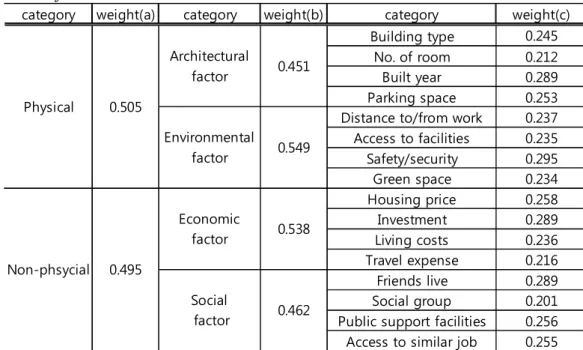
Employment status
On the other hand, the employed group is more sensitive to the architectural factors than the unemployed group. At level 3, the employed groups have a greater emphasis on the 'Building year', and the unemployed have a greater emphasis on the 'Building type' in architectural terms. In terms of environmental factors, the most important factor is the 'Feeling of security' for both employed and unemployed.
For economic aspects, the 'Investment' is the most important factor for the unemployed than the unemployed, but the 'Cost of Living' and the 'Housing Price' are the most important factors for the unemployed and have greater weights than the unemployed. Finally, the 'Where friends live' is the main concern for both the unemployed and employed groups, but slightly the employed have higher weight than the unemployed. The 'Social group' is a least important factor in the social factors; however, the employed have a greater weight on the 'Social group' than the unemployed.
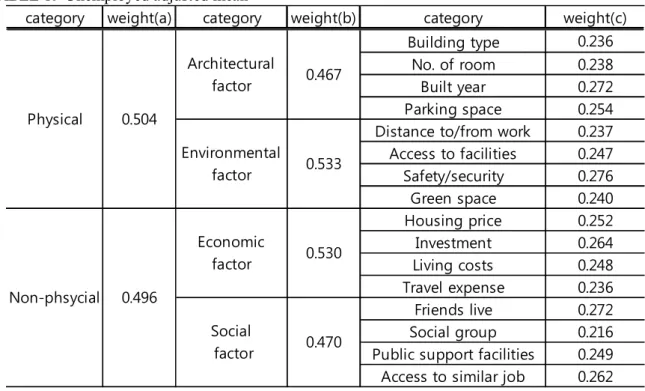
Results of In-depth Interview
- Nationality of In-depth Interviews
Put four factors in importance order for determine residential location selection
As Figure 15 shows, foreign-born female interviewees think that environmental factors are the most important factors, followed by economic, social and architectural factors of the four factors. The results show that most of the respondents are not concerned about social and architectural factors when they choose a residential location.
Is Social factors are importance on residential location selection?
Are ‘Social groups’ important to residential location selection
Is Public support facilities are importance on residential location selection?
One interviewee stated that "the location of the husband's workplace and the children's school are much more important than others." Others usually said, "You only meet your friends once or twice a week, so friends are important, but we can meet anywhere, so it doesn't matter where your friends live." Conversely, a few respondents said that it did not matter because they "learn only Korean and nothing else," and a few foreigners mentioned that Koreans want to speak English because they are from English-speaking countries such as the US, Canada, and the UK. with them so that they don't feel the need to learn Korean while living in Korea. In addition, one foreigner from an English-speaking country pointed out that, according to him, "multicultural family centers only focus on Southeast Asians, such as Vietnamese, Indonesian, Chinese, and Filipino, so they are not really useful for us and they are not in our really useful for all multicultural families".
Do you consider the location of public support facilities when you looking for a house?
How to improve a quality of service for the public support facilities?
They felt that once they learned Korean, the need for public support facilities became less valuable to them. A number of foreign-born women mentioned that they would like to use public support facilities, but that they are difficult to access even if they wanted to, because their opening hours overlap with the opening hours of support facilities. public. Residents of foreign origin state that they hoped that there would be public services available to them in the evening on weekends and during the day on weekends in the near future.
These efforts have the potential to improve their quality of life and performance in the long run, and would therefore benefit both the foreign-born population and their jobs. As one of the interlocutors pointed out, "it is so difficult to concentrate during class. The class is also so difficult for me and my child that a few people with the same problem dropped out of the course because they couldn't handle their child and the class."
Is there any comment or suggestion and recommendation that you would like to tell the Korean government regarding Housing policy issues to make a better housing policy for
- Discussion and Conclusions
- Discussion
- Reviews on Research questions
- Do foreign and domestic residents have different criteria when it comes to selecting a residential area in which to live?
- What factors are most important to domestic and foreign-born residents in selecting a residential location?
- Are social factors more important to foreign born residents than domestic residents when determining a residential location?
- Are public support facilities helpful for new foreign-born residents?
- How can the Korean government improve public support facilities?
- What steps can the Korean government take to improve the quality of life of foreign- born residents?
- Conclusions
The different residential location preferences between local and foreign residents are not simply based on their socio-economic status. In general, local and foreign residents generally have similar criteria for choosing a residential location in four factors (Environmental > Economic > Social > Architecture). Which factors are most important for local and foreign residents in choosing a residential location?
The most important factors for both native and foreign-born residents are environmental and economic factors. This study assessed and compared residential location choices among native-born and foreign-born women. As expected, there is a difference in the weighting of residential location between native and foreign-born residents.
Kenyon, E & Heath, S 2001, 'Choosing this life: narratives of choice among house dwellers', Housing Studies, vol. Kim, H.,S., 2012, 'Analyzing Housing Determinants of Seoul Residents Using AHP', Architectural Institute of Korea, vol.1 p. Kim, M., Y., 2012, 'A study on housing support law policy for multicultural society', housing policy, Konkuk University 2012 volume 23.
Morrow-Jones, HA, Irwin, EG & Roe, B 2004, 'Consumer Preference for Nontraditional Neighborhood Characteristics', Housing Policy Debate, vol. 2012, 'Housing Policy for a Multicultural Society: Status of Foreign Residence and Policy Support', Homeland Studies, Korea Research Institute of Human Settlements. Winstanely, A, Thrones, D & Perkins, HC 2002, 'Moving house, creating home: Exploring residential mobility', Housing Studies, vol.
Acknowledgements
